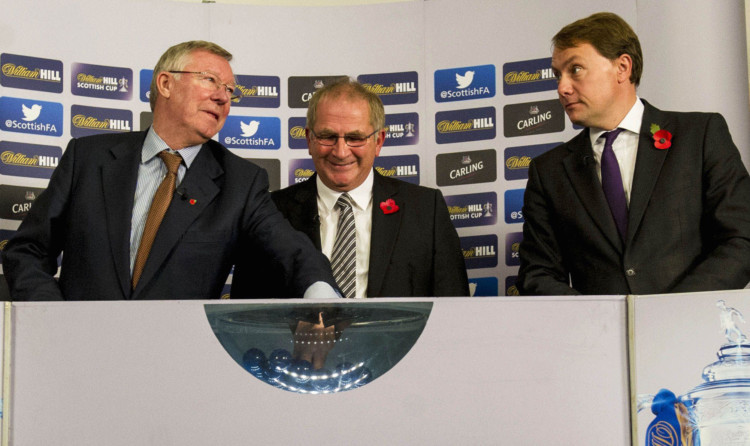We hear all the time that football is supposed to be about the fans, which makes the events of the past week or so seem all the more bizarre to me.
First we learn that Raith Rovers’ Ramsdens Cup final against Rangers will take place at Edinburgh’s Easter Road, which sparked plenty of debate in itself, before the SFA broke the news that both Scottish Cup semis will take place at Ibrox with the final at Celtic Park regardless of who makes it to the competition’s final four.
I’ve had plenty of conversations on both issues over the last few days and it’s fair to say that finding a consensus is nigh on impossible, so I do sympathise with the people making the decisions in some respects.
But that does not disguise the fact that both decisions are, in themselves, bonkers.
Taking the Ramsdens Cup first of all, it became abundantly clear by the quarter-final stage (if not earlier) that Rangers were highly likely to make it to the final and that that would necessitate a large enough venue to accommodate.
Even though the Rangers fans didn’t exactly turn out in their droves to previous rounds, the 16,097 crowd for the midweek tie against Berwick an example of that, you can bet your bottom dollar that Rangers could easily sell tickets for their first national final since the Ibrox club’s off-the-field problems hit home.
That’s a no-brainer.
Raith Rovers managed to muster over 8,000 fans to their Scottish Cup semi-final at Hampden versus Dundee United in 2010 and, while I’m not suggesting demand will be quite that high for the Ramsdens Cup showpiece, it’s fair to suggest that between 6,000 and 7,000 supporters might be a realistic starting point.
Taking those kind of figures on board, I’m always one for seeing crowds split right down the middle where possible but when you have an equation like that Rangers typically attracting over 45,000 to a League One game and Raith with a best case scenario of around 8,000 then surely common sense has to prevail?
With Hampden out of commission for the Commonwealth Games, there are only a handful of stadia capable of meeting that sort of demand.
In my book, Celtic Park could, and should, have been the venue, and I have yet to hear a good enough reason as to why it is not in the running.
We could all hazard a guess, but it would be nice if someone explained it to us mere mortals rather than simply bypassing the issue.
Ibrox itself was also put forward as a suggestion but, in the spirit of fairness and for fear of setting an unwanted precedent, home advantage should not come into it when it comes to a final.
In my opinion, it has to be a neutral venue. It’s a cup final after all.
So that takes us to Edinburgh, the city the SPFL say was chosen because of the near-equal travelling distance for both clubs, and Easter Road, which the SPFL say was chosen over Tynecastle (and even Murrayfield, which has remained conspicuous by its absence in discussions) because of its larger capacity.
Ally McCoist said he was baffled by the decision, and he’s certainly not the only one.
You’ll have thousands of fans, mainly Rangers supporters I might add but also Rovers fans as well, clamouring for tickets to a one-off game, only to find themselves likely to miss out as Easter Road only holds 20,421.
I’ve nothing against Easter Road. I like Easter Road as a venue and have plenty fond memories of going there over the years.
Holding the game there not only means that you are missing out on at least 20,000 fans, all of whom would be willing to go and make a great day of it and would be willing to part with their hard-earned cash at a time when the Scottish game needs more folk through the turnstiles.
But to be honest, decisions like the one made in relation to the Ramsdens pale into insignificance in comparison to one made about the Scottish Cup semis and final.
Football is supposed to be about the fans so, with Hampden unavailable, what sense does it make to announce the venues now?
I’ve already talked about home advantage and, although I’ve heard Peter Lawwell come out this week and say that there would be an even distribution of tickets if Celtic get there, it’s still Celtic Park the clue is in the green and white seats which spell out CELTIC on one side of the ground when its empty.
Celtic play there every second week, sometimes more, so there’s an unfair advantage. And the same has to be said with the choice of Ibrox for the semi-finals.
The SFA understandably came out with their swift defence, saying issues like stadium rental, insurance, stewarding etc all needed planning well before finals and semi-finals and that it would be more cost-effective to do so.
But I’m sorry, I don’t seem to remember these being major considerations in October in past seasons.
What if, say, Aberdeen meet Inverness in one of the semis? Will their teams and fans be expected to traipse down to Glasgow for a Saturday lunchtime kick-off, as has happened in the past, when other venues might be more suitable for all concerned?
And what if Rangers, which is not beyond the realms of possibility, make it to the final giving them home advantage in the semi – and Celtic are their opponents?
I’m sure Police Scotland would be chuffed with that prospect.
I’m not saying choosing a venue for these big games is easy, because it isn’t.
Indeed, one media colleague of mine said the topic was great because, and I quote, “there are no right answers”.
I agree with him on that.
But there are sensible ones.
